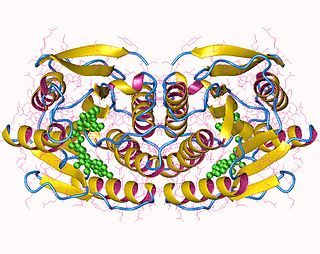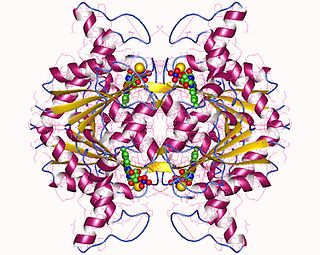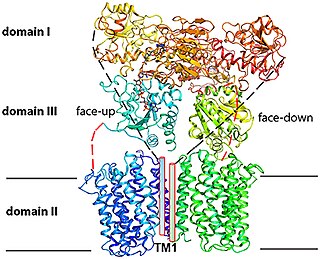A dehydrogenase is an enzyme belonging to the group of oxidoreductases that oxidizes a substrate by reducing an electron acceptor, usually NAD+/NADP+ or a flavin coenzyme such as FAD or FMN. Like all catalysts, they catalyze reverse as well as forward reactions, and in some cases this has physiological significance: for example, alcohol dehydrogenase catalyzes the oxidation of ethanol to acetaldehyde in animals, but in yeast it catalyzes the production of ethanol from acetaldehyde.

Nicotinamide adenine dinucleotide (NAD) is a coenzyme central to metabolism. Found in all living cells, NAD is called a dinucleotide because it consists of two nucleotides joined through their phosphate groups. One nucleotide contains an adenine nucleobase and the other, nicotinamide. NAD exists in two forms: an oxidized and reduced form, abbreviated as NAD+ and NADH (H for hydrogen), respectively.
In enzymology, a L-glycol dehydrogenase (EC 1.1.1.185) is an enzyme that catalyzes the chemical reaction
In enzymology, a mannuronate reductase (EC 1.1.1.131) is an enzyme that catalyzes the chemical reaction
In enzymology, a testosterone 17beta-dehydrogenase is an enzyme that catalyzes the chemical reaction between testosterone and androst-4-ene-3,17-dione. This enzyme belongs to the family of oxidoreductases, specifically those acting on the CH-OH group of donor with NAD+ or NADP+ as acceptor.
In enzymology, a 3alpha-hydroxysteroid dehydrogenase (B-specific) (EC 1.1.1.50) is an enzyme that catalyzes the chemical reaction
In enzymology, an enoyl-[acyl-carrier-protein] reductase (NADPH, A-specific) (EC 1.3.1.39) is an enzyme that catalyzes the chemical reaction

In enzymology, a L-aminoadipate-semialdehyde dehydrogenase (EC 1.2.1.31) is an enzyme that catalyzes the chemical reaction
In enzymology, a ferredoxin–NAD+ reductase (EC 1.18.1.3) is an enzyme that catalyzes the chemical reaction:
In enzymology, a rubredoxin—NAD(P)+ reductase (EC 1.18.1.4) is an enzyme that catalyzes the chemical reaction
In enzymology, a rubredoxin-NAD+ reductase (EC 1.18.1.1) is an enzyme that catalyzes the chemical reaction.

In enzymology, 6,7-dihydropteridine reductase (EC 1.5.1.34, also Dihydrobiopterin reductase) is an enzyme that catalyzes the chemical reaction
Azobenzene reductase also known as azoreductase (EC 1.7.1.6) is an enzyme that catalyzes the chemical reaction:

In enzymology, a glutamate synthase (NADPH) (EC 1.4.1.13) is an enzyme that catalyzes the chemical reaction
In enzymology, a NADPH—cytochrome-c2 reductase (EC 1.6.2.5) is an enzyme that catalyzes the chemical reaction

In enzymology, a NAD(P)H dehydrogenase (quinone) (EC 1.6.5.2) is an enzyme that catalyzes the chemical reaction
In biochemistry, NAD(P)+ transhydrogenase (Si-specific) (EC 1.6.1.1) is an enzyme that catalyzes the chemical reaction
In enzymology, a nitrite reductase [NAD(P)H] (EC 1.7.1.4) is an enzyme that catalyzes the chemical reaction
NADH dehydrogenase is an enzyme that converts nicotinamide adenine dinucleotide (NAD) from its reduced form (NADH) to its oxidized form (NAD+). Members of the NADH dehydrogenase family and analogues are commonly systematically named using the format NADH:acceptor oxidoreductase. The chemical reaction these enzymes catalyze is generally represented with the following equation:

Proton-Translocating NAD(P)+ Transhydrogenase (E.C. 7.1.1.1) is an enzyme in that catalyzes the translocation of hydrons that are connected to the redox reaction NADH + NADP+ + H+outside => NAD+ + NADPH + H+inside








